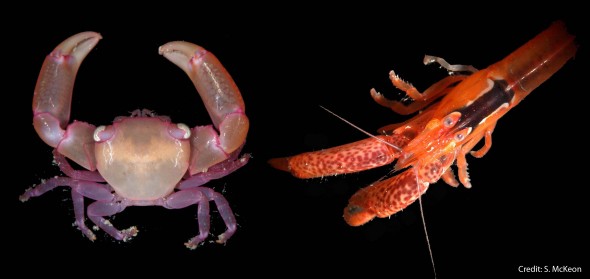 This is a guest post by Dr Adrian Stier
This is a guest post by Dr Adrian Stier
Coral reefs are among the most species rich ecosystems on earth, but what most people don’t know is that the majority of reef biodiversity is housed inside the reef. Indeed, in the South Pacific, a coral the size of a basketball can house over 50 different species of crustaceans. Yet biologists know very little about the ecology of these invertebrate communities that lie under the reef’s hood. Recent work sheds light on important ecological services these cryptic critters provide to the reef.
Early work suggested that some of the invertebrates that live inside the reef (particularly those crabs of the genus Trapezia) form a mutualism with their coral host. The coral provides shelter and food in exchange for protective services such as guarding behavior (protecting the coral from carnivorous seastars) or through housekeeping services (cleaning the coral of sediment). Such mutualisms are a marine analogue to a well-known ant-plant mutualism where ants protect plants from herbivores in exchange for nectar (food) and domatia (places to live). However, early studies of coral-crustacean mutualisms largely ignored the possible importance of interactions between different species of invertebrates housed within the coral.
Our recent work published in three separate journal articles has increased our understanding of this important mutualism between the coral and its crustacean inhabitants in two ways: (1) We described new ways in which crustacean mutualists benefit the coral. (2) We explored how synergisms and antagonisms among different symbiont species affect the strength and stability of the mutualism.
In two recently published companion papers published in the journals PLoS ONE and Oecologia we manipulated two coral symbionts (a crab: Trapezia serenei and a shrimp: Alpheus lottini) and measured how the guarding and housekeeping ability of crustaceans shift with crustacean density, identity, and diversity. Generally, we show that more mutualists is better and that these crustaceans provide their services to the coral independently; however, in some cases, these crabs and shrimp cooperate and collectively are better than expected when measured independently. A third paper published recently in 2010 in the journal Coral Reefs describes a new service provided by the crab Trapezia serenei where by the are capable of ameliorating the negative effects of mucus-feeding snails (Dendrapoma maxima) that lives embedded in the coral.
Our findings suggest corals with a greater number of symbionts are more likely to persist in the presence of adverse conditions (e.g., seastar outbreaks and sediment runoff from agriculture), emphasizing the key importance of these symbionts in maintaining the health of threatened coral reefs.
This system is exciting and offers extraordinary opportunity to understand more about the dynamics of a poorly studied, yet extraordinarily diverse guild of reef invertebrates that live hidden within the matrix of the reef.
This work has benefited immensely from contributions by a suite of collaborators: Mike Gil, Sarah Lemer, Matthieu Leray, Sea Mckeon, Suzie Mills, Craig Osenberg, and Jeff Shima. (listed alphabetically).
Leave a Reply